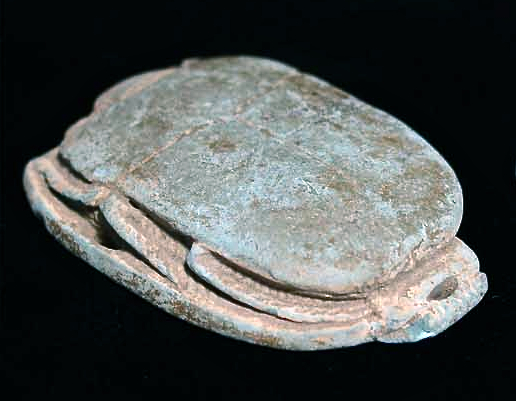

Title: Egyptian Greenstone Heart Beetle Scarab Insect Artifact Mummie Tool
Shipping: $29.00
Artist: N/A
Period: Antiquity
History: N/A
Origin: N/A
Condition: Museum Quality
Item Date: 2nd-1st millennium BC
Item ID: 5935
EGYPTIAN GREENSTONE HEART SCARAB. 2nd-1st millennium BC. These large scarabs were placed over the chest of important mummies. 2.25 inches. High quality example with a few chips. Nice detail. All of the art is edited and chosen by us for its high quality and workmanship before posting. We are committed to enhancing our customer’s lives by discovering creating, and pointing out only the best art we can find in the world today. We Are Taste-Makers, Art Advisers, Consultants & Publishers Of Spectacular Art Stories. Our job is to be intermediaries between buyers and sellers. We are vetting for high end art patrons. We are determined to catalog the world's most exceptional art and share it with everyone.
Link: http://en.wikipedia.org/wiki/Scarabaeus_sacer
Scarabaeus sacer is the most famous of the scarab beetles.[7] To the Ancient Egyptians, S. sacer was a symbol of Khepri, the early morning manifestation of the sun god Ra, from an analogy between the beetle's behaviour of rolling a ball of dung across the ground and Khepri's task of rolling the sun across the sky.
The Egyptians also observed young beetles emerging from the ball of dung, from which they mistakenly inferred that the female beetle was able to reproduce without needing a male. From this, they drew parallels with their god Atum, who also begat children alone.
Scarabaeus sacer was the species which first piqued the interest of William Sharp Macleay and drew him into a career in entomology.
Scarabaeus sacer is a species of dung beetle. It occurs in coastal dunes and marshes around the Mediterranean Basin. Among the coprophagous species of beetles, it is typical of those that collect dung into balls. Such a beetle rolls its ball to a suitable location, where it digs an underground chamber in which it hides the ball. It then either eats the ball itself, or lays an egg in it, covers the chamber, and departs, repeating the procedure as many times as it can. The larva feeds on the ball of dung after the egg hatches. This behaviour inspired the Ancient Egyptians to compare Scarabaeus sacer to Khepri, their Sun god. They accordingly held the species to be sacred.
The head of Scarabaeus sacer has a distinctive array of six projections, resembling rays. The projections are uniform with four more projections on the each of the tibiae of the front legs, creating an arc of fourteen "rays". (See illustration.) Functionally the projections are adaptations for digging and for shaping the ball of dung.
Like the front legs of other beetles in its genus, but unlike those of dung beetles in most other genera, the front legs of Scarabaeus sacer are unusual; they do not end in any recognisable tarsus, the foot that bears the claws. There is only a vestigial claw-like structure that might be of some assistance in digging. The mid- and hind-legs of Scarabaeus have normal, well-developed 5-segmented tarsi, but the front legs are specialised for excavation and for forming balls of dung.